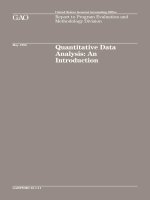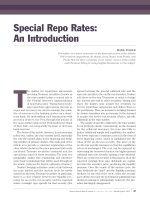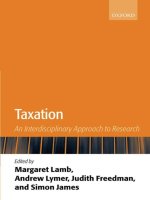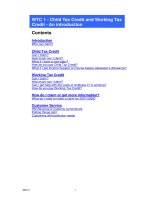An introduction toreinsurance swiss re
Bạn đang xem bản rút gọn của tài liệu. Xem và tải ngay bản đầy đủ của tài liệu tại đây (190.95 KB, 37 trang )
An introduction to
reinsurance
An introduction to reinsurance
2
Contents
1. The history of insurance and reinsurance 4
2. The history of Swiss Re (SR) 8
3. A definition of reinsurance 11
4. The nature and function of reinsurance 12
5. Who offers reinsurance? 16
6. Who are the largest reinsurers? 17
7. From policyholder to retrocession 18
Risk sharing with reinsurance: a schematic diagram
8. Basic forms of reinsurance 20
9. Basic types of reinsurance: 21
proportional and non-proportional
10. Direct insurers and reinsurers: a comparison 31
11. Freedom and its consequences 32
Sources 34
Technical terms 34
Classes of business 36
An introduction to reinsurance
Foreword
To the reader,
Many authors have written a great many works on reinsurance, and Swiss
Re’s publication of An introduction to reinsurance is adding yet another title
to this long list. You may justifiably ask, “Do we really need this brochure?”
We believe that the answer is yes– and for good reason.
To our way of thinking, introductions to reinsurance are either too rudimen-
tary or too comprehensive: the first do not provide the examples necessary
for a clear understanding of the subject, while the second go too much into
detail, and are addressed to readers already familiar with the reinsurance
basics or who have easy access to more specialized literature.
This publication is meant to be different. An introduction to reinsurance is
designed as a training text: it limits itself to the basics of reinsurance, and
explains them in an understandable way. Compiled from diverse sources and
enriched with examples and illustrations, it also says a good deal about the
way Swiss Re does business.
And because our environment is dynamic and rapidly changing, we have not
written An introduction to reinsurance as a definitive work, one for all time,
but as one that we will expand and– when necessary– update as the situation
demands.
Product Management
Knowledge Transfer
3
1.
The history of insurance and reinsurance
Striving for security, making provisions
Man’s desire for security, his wish to provide against future uncertainty, is as
old as the human race itself. At first, he could only try to satisfy this need by
helping himself; later, he found support in the family, the clan, the guilds.
It is this idea– the notion of community, of “one for all and all for one”that
is very basic to insurance. In a world where labor is increasingly specialized
and value is increasingly concentrated, insurance has grown steadily in
importance.
Once, Henry Ford I heard a visitor to New York express wonder at the sight
of the magnificent city with its soaring buildings. Ford’s reply fittingly
characterized the significance of insurance in our modern world: “This has
only been made possible by the insurers,”he said. “They are the ones who
really built this city. With no insurance, there would be no skyscrapers. No
investor would finance buildings that one cigarette butt could burn to the
ground.”
The origins of insurance
It is in marine commerce that we first find the idea both of direct insurance
and of reinsurance. Yet while we have evidence of transport cover going back
to before the Christian era, the oldest known contract with reinsurance
characteristics was concluded much later: in the year1370, in Genoa.
Economic upturn favored development
As trade expanded in the late Middle Ages and the economy flourished–
especially in the Italian city-states, Flanders and the cities of the Hanseatic
League– a true commercial insurance business grew up. Insurers of the
period worked without statistics, rates, or calculations of probability, relying
solely on their personal assessment of the risks
1
. Thus, when news of a loss
came through, many an insurer had to ask himself fearfully whether he had
taken on too much risk. To protect himself against such situations, he soon
learned to transfer part or all of the risk to another insurer willing to accept
it by way of reinsurance.
Besides reinsurance which at that time covered only individual risks (see
“Facultative reinsurance”in Chap.8), the period’s other main risk-sharing
instrument was co-insurance
2
. As an English law of 1746 virtually prohibited
reinsurance, direct insurers had to band together into syndicates if they were
to cover risks beyond their individual financial means. Thus the law
unintentionally strengthened Lloyd’s of London, the world’s most famous
insurance institution (see Chap.5).
4
1
In underwriting, the term
risk
refers not only to abstract
hazards but also to the actual
object insured: a ship, for
example.
2
Co-insurance:
when several
direct insurers participate on a
single risk.
The first insurance companies
After marine insurance, the first great step in the history of the insurance
industry, came the second: insurance against fire hazards. For example, after a
number of serious fires struck Hamburg between 1672 and1676, the Ham-
burgische Feuerkasse (Hamburg Fire Fund) was set up: today, this is the
world’s oldest existing insurance company.
In1706, the founding of the Amicable or Perpetual Assurance in London finally
marked the breakthrough of actuarial science as a means of assessing risks and
setting rates.
Other foundation stones of the modern insurance industry were laid during
the nineteenth century: this age witnessed the founding of numerous insu-
rance companies still in business today. Innovations included the rise of a
modern form of reinsurance aimed at balancing portfolios on an inter-
national level; the addition of new classes of insurance to the industry; and
the creation of social insurance plans.
Insurance’s rapid evolution in the last century can only be explained in the
context of economic development: the transformation of technology, the
remodeling of society, the change in ways of thinking. Within a few decades,
an entirely new, rational world-view took hold: it tore man away from his
relative immaturity and forced him to adopt an independent, responsible
attitude to life and the world around him. The increased need for security
which this new age brought with it was the origin of the insurance business
as we know it today.
From the individual risk to the portfolio
Reinsurance, too, in its modern form, was the product of these events. As
industrialization produced concentrations of value, insurance companies’
demand for reinsurance cover boomed. Treaty reinsurance, which provided
cover for portfolios (groups of risks), took its place beside the single-risk,
facultative form of reinsurance customary until that time. Treaties, which are
still in use today, are discussed under “Obligatory reinsurance”(Chap.8).
Another catastrophic fire in Hamburg in 1842 gave the immediate impulse
for the founding of Cologne Reinsurance Company, the first professional
reinsurance company.
3
The reserves of the locally-based Hamburg Fire Fund,
only 500,000 marks, had not been nearly sufficient to cover the loss of
18 million marks. Thus, as a result of this event, insurers finally addressed the
need to distribute entire portfolios of policies among several risk carriers (see
Chap.4).
5
3
A
professional
reinsurance
company such as Swiss Re
engages exclusively in rein-
surance.
Professional reinsurers
Though at first it was mainly the financially stronger direct insurers who
engaged in reinsurance, the Cologne Reinsurance Company was the pre-
decessor of a long line of professional reinsurance companies founded soon
after. Among these were:
– Aachen Re in1853;
– Frankfurt Re in 1857;
– Swiss Reinsurance Company in 1863; and
– Munich Reinsurance Company in 1880.
The founding of such professional companies specializing in reinsurance
was of great importance for insurance operations and the further develop-
ment of the industry. Under the co-insurance arrangement used until then,
participation on the same policy by several insurers meant that each had
knowledge of the others’ underwriting, a situation that encouraged unfair
competitive practices: the reinsurer eliminated this disadvantage. In addition,
specialization allowed new forms of reinsurance to develop, while the globe-
spanning activity of the reinsurers not only permitted risks to be spread more
effectively, but also provided international experience. This has improved the
protection offered by reinsurance, and contributed indirectly to improving
the conditions which reinsurers are able to offer their clients.
The insurance industry reaches maturity
The twentieth century, too, has been characterized by a wave of new rein-
surance companies founded in numerous countries. In addition, the direct
insurers have intensified their reinsurance activities. Today, Standard& Poor’s
lists approximately135 professional reinsurers worldwide, as well as around
2000 direct insurers that also write reinsurance business.
The great number of direct insurers and reinsurers is proof that the insurance
industry’s prime, which began with the full flowering of the industrial revo-
lution in the last century, is far from over. Today, however, at the end of the
twentieth century, the European insurance industry in particular finds itself
confronted with a new development. Liberalization as a result of the
European single market is bringing about the disappearance of the strictly
supervised, nationally regulated system which has existed for generations.
Today, deregulation of the insurance business is leading to more intensive
competition.
6
The basis of modern insurance:
the law of large numbers
To set premium rates, insurers must be able to predict future losses. How-
ever, it is impossible to predict the exact moment fate will strike any one
individual, or the extent of the loss that this blow will cause. Thus insurers
consider large groups of their clients under the assumption that each is
exposed to the same types of risk, and that each loss is a separate event.
In such cases, the larger the group, the closer the average loss will approach
a definite value. This is the result described by the law of large numbers,
discovered by Jakob Bernoulli around1700.
Thanks to this law, an insurer can predict the total annual loss to be expected
for the group much more accurately than for any one individual. The pro-
jected losses are then distributed among those insured, thereby determining
the premium.
Today, insurers make extensive use of statistics to calculate the expected losses
and distribute them over the individual premiums. Statistics are always based
on the past, but the laws of probability make it possible to apply these data
to the present and to predict future trends. Though the theory of probability
is highly developed, there may be differences between prediction and reality:
this is known as underwriting (or actuarial) risk (see Chap.4). This is why
reinsurance is needed.
Example:
No one can know beforehand when a particular individual will die. However,
based on experience and observation, we can predict with fair accuracy how
many female (or male) newborns will attain the age of 20 years, for example,
or 50 years, or 60 years.
7
2.
The history of Swiss Re (SR)
From 1863 to World War I: the pioneering age
Like the Hamburg fire of 1842, the1861 fire in Glarus, Switzerland made
painfully clear that the reserves normally set aside by insurance companies
were inadequate for such catastrophes. To better prepare for such risks, the
Helvetia General Insurance Company in St.Gall, Credit Suisse of Zurich and
the Basle Commercial Bank founded the Swiss Reinsurance Company in
Zurich in1863. The bylaws, approved by the Governing Council of the
Canton of Zurich, bear the signature of the Swiss poet Gottfried Keller, the
canton’s First Secretary at the time.
Although Swiss Re concluded treaties with foreign ceding companies as early
as1864, it proved difficult to gain a firm foothold abroad. It was not until
the devastating San Francisco earthquake and fire of 1906, which brought the
company a gross loss of 8.4 million Swiss francs (50% of total annual fire
premiums), that Swiss Re’s prompt, accommodating settlement of claims
brought it a worldwide reputation. The result was a commensurate increase
in business: Swiss Re established its first branch office in New York in 1910.
Between the wars: a period of expansion
Swiss Re’s initial wave of expansion into the US and Great Britain was
followed by a second during the1920s which concentrated on continental
Europe. At this time, Swiss Re acquired an interest in a total of 31 direct
insurers and reinsurers in11 countries, predominantly in Germany. Despite
the collapse of currency (1919–1924) and Black Friday on the New York
Stock Exchange (1929), Swiss Re remained a solvent and reliable company.
The global economic crisis triggered by the1929 Wall Street Crash did leave
its mark on Swiss Re’s results, however, and huge losses had to be overcome.
Nevertheless, between the wars, Swiss Re succeeded in becoming the world’s
leading reinsurer.
8
After World War II: consolidation and adjustment
to the new world order
During World War II, wartime economic measures and Swiss neutrality
enabled Swiss Re to maintain most of its worldwide business relations. How-
ever, the post-war years brought sweeping changes. Although it was possible
to establish new subsidiaries and branch offices in various Western nations,
Swiss Re’s strong position in eastern Europe was lost when states of the
newly-formed Soviet bloc nationalized their assets. Also, the decolonization
of Africa and Asia made it necessary to adjust to completely new market
structures. The economic boom that began in the1960s placed considerable
demands on the company’s flexibility and innovative capacity. Swiss Re met
the new challenges in a number of ways, notably the foundation of the Swiss
Insurance Training Centre (SITC), originally for the training of insurance
specialists from third-world countries. To help it adapt to the new situation,
Swiss Re also made various changes in its organizational structure, such as
setting up its market-oriented departments in 1964 and adopting a triadic
organization (market/product/technical) in1973. A larger-scale reorganization
took place in1989 with the aim of combining the technical and marketing
departments; and in1992, the company was given a new management
concept. Reinsurance training was also modified at this time to reflect
changed conditions: modular courses for reinsurance specialists replaced the
prior curriculum, so that new employees could be prepared selectively and
efficiently for their specific duties.
Business growth and the steadily increasing number of staff (from 208
employees in1910 to 480 in1960, 1315 in 1990, and1800 by1995) made it
necessary to build or buy new premises: the New Building in 1969; the Escher
and Lavater Buildings, purchased in1972; the“Mythenschloss,”occupied in
1986. Beginning in1992, departments were relocated to the Gotthardstrasse,
to Sood/Adliswil, and to the Bederstrasse.
In1984, a new corporate strategy was drawn up to create a more diversified
range of reinsurance products that included supplementary services as well as
the core business of reinsurance cover. At this time, Swiss Re was able to
consolidate its position as the world’s second largest reinsurance company.
9
From 1992: a “universal insurance group”
In1989, with the sale of service companies having little or no connection
with insurance, Swiss Re began once more to concentrate on the insurance
business proper. This orientation was strengthened in1992, when new
strategic objectives were set out with the aim of transforming the company
into a“universal insurance group.”According to this strategy, Swiss Re
regarded itself as a group“operating mainly in the reinsurance and direct
insurance sectors, complemented by activities in the related areas of risk
management and claims handling.”To that end, on January1, 1993, company
management was divided between two independent bodies: a“Group Manage-
ment”and the“Executive Board of Swiss Re, Zurich (SR Operations).”
1994 onwards: concentration on the core business
At the end of September 1994, Swiss Re shareholders were informed of the
sale of its direct insurance companies in Switzerland, Germany, Italy and
Spain. The media received the following press release (excerpt):
Strategic Reorientation: Expansion of Reinsurance Business and Disinvestment in
Direct Insurance Sector.
The Swiss Re Group has begun its new strategic reorientation. In order to
further strengthen an already excellent position in all reinsurance markets
and to fully exploit the considerable opportunities that these markets provide,
Swiss Re Group will in the future concentrate on its core business– rein-
surance– as well as related services… Swiss Re has thus decided to sell its
majority holdings in European direct insurance companies… The substantial
funds derived from these sales will be used to reinforce the company’s capital
base, thus allowing the coherent expansion of its reinsurance business…
10
3.
A definition of reinsurance
“Reinsurance is insurance for insurance companies.”
More precisely, “Reinsurance is the transfer of part of the hazards or risks that
a direct insurer assumes by way of insurance contract or legal provision on
behalf of an insured, to a second insurance carrier, the reinsurer, who has no
direct contractual relationship with the insured.”
(Definition according to M.Grossmann, Reinsurance– An Introduction.)
Why is there a need for reinsurance?
Mainly, a direct insurer needs reinsurance so as:
– to limit (as much as possible) annual fluctuations in the losses he must
bear on his own account; and
– to be protected in case of catastrophe.
11
Policyholders
Policies takes on
hazards and
risks from the
policyholders
Direct insurer
Transfer of risk to
the direct insurer
Transfer of risk to
the reinsurer
takes on
hazards and
risks from the
direct insurer
Reinsurer
4.
The nature and function of reinsurance
4.1 The basic function of reinsurance
Reinsurance is therefore insurance for insurers. Reinsurance allows direct
insurers to free themselves from the part of a risk that exceeds their under-
writing capacity, or risks which, for one reason or another, they do not
wish to bear alone. Since a reinsurer’s clients and business associates are
insurance companies or other reinsurers, reinsurance companies in the past
had almost no contact with the public. By operating largely from this
“concealed position,”reinsurance acquired the aura of an arcane science. If
the public at large showed an interest in the function and problems of rein-
surance, it was usually because a reinsurance company was in difficulty, or
because it had to pay a large claim in the wake of a natural disaster. This has
changed: today, reinsurance companies, too, participate in the public
dialogue.
Individual risks and portfolios
Direct insurers find relief from particularly large individual risks by ceding
them individually in the form of facultative reinsurance (see Chap.9). How-
ever, entire portfolios containing all a direct insurer’s fire, motor or marine
insurance policies, for example, are also the object of reinsurance. These
insurance portfolios are covered by blanket agreements, so-called obligatory
reinsurance treaties (see Chap.8 – 9).
Balanced portfolios
Insurance portfolios can be structured very differently. To be considered
homogeneous (or“balanced”), an insurance portfolio should include many
similar and equivalent risks. In this way, losses can be balanced collectively,
meaning that the direct insurer will need little or no reinsurance. The motor
insurance portfolio of a large direct insurer comes closest to this ideal. If such
a portfolio includes enough individual risks (200,000 automobiles, for
example) the law of large numbers should apply, meaning that the loss (or
claims) ratio – the ratio of losses to premiums– should fluctuate only
minimally from year to year (see“The law of large numbers,”Chap.1).
Yet even a homogeneous insurance portfolio is subject to unexpected devia-
tions in claims experience due to the risk of random fluctuation
4
and the risk
of change
5
, which is why it is advisable to reinsure these portfolios as well.
12
4
Risk of random fluctuation:
large accidental (random)
losses such as the Munich
hailstorm of 1984, the spring
storms throughout Europe in
1990, or Hurricane Andrew in
the USA in 1992 will cause the
loss experience to deviate
from the long-term statistical
norm.
5
Risk of change:
see also the
definition in the Appendix. A
recent example is the unex-
pected jump in auto theft that
hit central European countries
after the lifting of the Iron
Curtain.
Unbalanced portfolios
Examples of portfolios with extremely poor balance are, above all, nuclear
power and aviation insurance covers. Here, a huge exposure arises from a
relatively small number of objects insured, through an accumulation of sums
insured under property, hull, liability and accident coverage. Such risks cannot
possibly be carried by a single insurance company, and indeed, cannot even
be reinsured effectively at all in some cases. It has become necessary to set up
national pools
6
which retain part of the exposure for national insurance com-
panies, passing on the larger share to foreign pools.
The above examples of well-balanced and poorly-balanced portfolios are
extremes. Between them lie fire, accident, liability, marine and life insurance
portfolios with normal reinsurance needs, though these needs may vary from
case to case.
How much reinsurance is necessary?
The question of just how much reinsurance to buy is a matter of judgement:
every direct insurer must arrive at an answer as part of his entrepreneurial
decision-making. His final decision will depend on factors such as willingness
to take on risk, his company’s financial strength, and market practice. How-
ever, there is no absolute security against bankruptcy. Reinsurance is merely
an instrument that can help a company reduce its probability of ruin.
13
6
Pool:
a treaty whose purpose
is to distribute the burden of a
relatively small number of
very heavy risks among the
greatest possible number of
national insurance carriers
operating in the relevant
branch.
4.2 How reinsurance affects the direct insurer
The reinsurer enhances in many ways the value of the services a direct insurer
provides to his clients.
– The reinsurer reduces the probability of the direct insurer’s ruin by
assuming his catastrophe risks.
– He stabilizes the direct insurer’s balance sheet by taking on a part of his
risk of random fluctuation, risk of change, and risk of error.
– He improves the balance of the direct insurer’s portfolio by covering large
sums insured and highly exposed risks.
– He enlarges the direct insurer’s underwriting capacity
7
by accepting a
proportional share of the risks and by providing part of the necessary
reserves.
– He increases the amount of capital effectively available to the direct insurer
by freeing equity that was tied up to cover risks.
– He enhances the effectiveness of the direct insurer’s operations by
providing many kinds of services, for example, by
• compiling and presenting underwriting data from sources around the
world;
• assessing and evaluating special risks;
• offering consultation in loss prevention;
• providing loss adjustment support;
• performing actuarial work;
• training members of the ceding company’s staff;
• helping ceding companies to invest their capital, to recruit managerial
staff, find cooperation partners, arrange mergers, etc.
14
7
Underwriting capacity:
the
maximum gross amount of
risk that an insurance com-
pany is able to accept, either
in writing individual risks or
as an accumulated loss
(especially natural hazards).
4.3 How reinsurance benefits the direct insurer
The direct insurer’s goals
The direct insurer uses reinsurance to pursue a variety of goals.
– Through facultative reinsurance (see Chap.8 & 9), he:
• reduces his commitments for large individual risks such as car factories
and large department stores;
• protects himself against large liability exposures, the extent of which
cannot be properly estimated before losses occur, as in the case of
products liability for pharmaceuticals.
– Through non-proportional treaty reinsurance (see Chap.9, especially 9.2),
he:
• receives cover for catastrophe risks such as hail, windstorm, earthquake
and flood, as well as large road, aviation and marine accidents.
– Through proportional treaty reinsurance (see Chap.9, especially 9.1), he:
• finds protection against major deviations in the loss experience of entire
portfolios (risk of random fluctuation, for example, or risk of change
due to economic cycles, or new laws and regulations, or social change).
– Through financial reinsurance, he:
• procures cover for difficult-to-insure or marginally insurable individual
risks or portfolios in order to guarantee liquidity and income. The
majority of claims incurred are balanced on a medium to long-term basis
by the direct insurer and reinsurer operating in tandem (and not within
a single year by a collective pool of many direct insurers).
Consequences for the reinsurer
Mainly, therefore, the reinsurer is offered highly exposed risks, catastrophe
risks and other severe or hazardous business. It is the reinsurance company’s
task to come as close as possible to the client’s wishes in providing cover,
while at the same time structuring and safeguarding its own reinsurance
portfolio to achieve a technical balance, not to mention making a profit.
The reinsurer thus seeks to balance his portfolio by spreading his activities
over many countries (geographical distribution) and throughout all branches
of the insurance business.
He keeps his probability of ruin low through:
– exposure and accumulation control
8
together with a suitable acceptance
and underwriting policy
9
;
– maintaining long-term client relationships, to achieve compensation in
time;
– underwriting, when possible, the more balanced portions of the direct
insurer’s business (eg motor third-party and personal third-party liability,
house contents and plate glass insurance),
– further reinsuring (retroceding) those risks which exceed his own capacity
(see Chap.7).
15
8
Exposure and accumulation
control:
so as not to exceed
the underwriting capacity it
has set for itself, a company
must keep track of all risks
written in branches of in-
surance exposed to accumu-
lation (especially natural
hazards like windstorm, earth-
quake and flood), whether this
exposure is direct (by way of
reinsurance)or indirect (by
way of retrocession, see
Chap.7).
9
Acceptance and underwriting
policy:
guidelines on what
share of what business should
be written, and under which
conditions.
5.
Who offers reinsurance?
16
The top four reinsurers have a market share amounting to 39% of the rein-
surance business. The syndicates that have banded together in London’s
“Corporation of Lloyd’s,”with its more than three centuries of history, operate
both in the direct insurance and reinsurance markets. Here, reinsurance covers
are bought on an exchange system similar to a stock market. Lloyd’s has
established a particular reputation for marine insurance and the coverage of
unusual risks. For special types of risk, such as aviation or nuclear energy,
insurance pools have been created. These are mainly designed to balance risks
at the national level, and attempt to secure international cover for themselves
with reinsurers or foreign pools.
In addition to the professional reinsurers, a number of large direct insurance
companies write reinsurance business, either through their own reinsurance
departments or through reinsurance subsidiaries.
Reinsurance brokers act as intermediaries in providing direct insurers with
reinsurance cover. They play an especially significant role in the Anglo-
American regions of the world.
Swiss Re works together with all these institutions and companies, though in
some ways it also competes with them.
The following table presents an overview of the world’s ten largest
reinsurance companies, listed in order of net premium volume
10
.
From1984 to1994, the market share of the four largest reinsurers increased
from 22% to 39%.
In1994, reinsurance markets generated a gross premium volume of about
$94 billion.
6.
Who are the largest reinsurers?
17
12
Technical reserves:
reserves
for losses incurred but not yet
paid or for losses incurred but
not reported (IBNR) by the
direct insurer; or for claims
incurred, but for which not
enough was reserved by the
direct insurer (IBNeR =
incurred but not enough
reserved).
13
Combined ratio:
see
“ Technical terms,” p. 34.
Standard & Poor’s rankings of the world’s ten largest reinsurance
companies
11
10
Net premium volume:
total
premiums written minus
retrocessions.
11
This table shows figures for
1994, the latest available at
the time of publication.
1 Munich Re D 10’437,4 11,4% 262,8% 103,6%
2 Swiss Re CH 5’100,0 4,8% 214,6% 132,3%
3 General Re US 2’374,6 19,3% 289,9% 101,6%
4 Cologne Re D 2’058,0 18,5% 193,6% 99,8%
5 Gerling Globale Re D 1’977,3 20,5% 214,2% 107,3%
6 Employers Re US 1’892,8 13,2% 262,1% 103,9%
7 Hannover Re D 1’ 741,5 23,3% 215,6% 96,5%
8 Frankona Re D 1’699,4 19,0% 184,1% 100,9%
9 American Re US 1’536,2 20,1% 205,4% 103,8%
10 Mercantile & General Re UK 1’ 514,7 409,5% 120,4%
Technical
Net premiums reserves
12
/ Combined
Company Country in US $ millions Retrocession net premiums Ratio
13
Risk sharing with reinsurance: a schematic diagram
7.
From policyholder to retrocession
Policyholders
Insurance contract (policy)
Direct insurer
The direct insurer accepts the risk, for which he is fully liable to the
policyholder.
Cession (transfer to a reinsurance company)
If the direct insurer does not want to keep the entire risk, he cedes a share to
one or more reinsurers, thus becoming a“cedent.”
Reinsurer
The reinsurer is a company which accepts a share of the risk, for which he is
liable to the direct insurer.
Retrocession
If the reinsurer does not want to keep his share of the risk in full, he will in
turn“retrocede”a share to one or more“retrocessionaires”(other reinsurers),
thus becoming a“retroceding company.”
Retrocessionaire
The retrocessionaire accepts a share of the risk, for which he is liable to the
reinsurer.
18
One policy = one risk
Several policies
= one portfolio
Several cessions
(treaties)
= one portfolio
Several retrocessions
(retrocession treaties)
= one portfolio
100% 100% 100%
60% 60% 50%
30% 30% 25%
19
Risk Risk sharing
8.
Basic forms of reinsurance
Facultative reinsurance
– Facultative reinsurance is reinsurance for individual risks.
In this, the oldest form of reinsurance, the direct insurer is free to choose
which particular, individual risks he wants to reinsure; and the reinsurer, for
his part, is free either to accept or refuse any risk offered to him: hence the
term facultative. A direct insurer who elects to reinsure a risk facultatively
must present the reinsurer with a precisely defined offer containing all
pertinent information on the risk in question. The reinsurer, after detailed
examination, will decide whether or not to accept it.
A direct insurer turns to facultative reinsurance in two cases: when he is left
with a sum remaining to be insured after both his retention
14
and his obli-
gatory reinsurance capacity (see below) are exhausted; or when a policy
contains risks that are excluded from his obligatory reinsurance cover.
With proportional reinsurance, the direct insurer must offer a risk for which
he requires facultative cover on the same terms and for the same premium
that he himself received from the policyholder (original conditions): the
terms and conditions finally agreed upon may deviate from these original
conditions, however. This clearly demonstrates that though the reinsurance
contract is entirely independent of the contract between the policyholder and
the direct insurer, the conditions largely correspond unless agreed otherwise.
Between the policyholder and the reinsurer, there is no contractual relation-
ship of any kind, and there is thus no mutual legal obligation between them.
Facultative reinsurance agreements may be either proportional or non-
proportional in form (see Chap.9).
Obligatory reinsurance
– Obligatory reinsurance is treaty reinsurance for entire portfolios: automatic
reinsurance.
In obligatory reinsurance, the direct insurer is obliged to cede to the reinsurer
a contractually agreed share of the risks defined in the reinsurance treaty; the
reinsurer is obliged to accept that share: hence the term obligatory.
The reinsurer cannot therefore refuse to provide insurance protection for an
individual risk falling within the scope of the treaty, nor may the direct
insurer decide not to cede such a risk to the reinsurer. As a rule, obligatory
reinsurance treaties are terminable on an annual basis.
20
14
Retention:
that portion of a
risk which the direct insurer is
willing and able to carry itself.
9.
Basic types of reinsurance:
proportional and non-proportional
Both forms of reinsurance (facultative and obligatory) may be either
proportional or non-proportional in type. This chapter will briefly survey the
two types, then proceed to a more detailed consideration of the reinsurance
contracts that are typical for each.
Proportional reinsurance
In all varieties of proportional reinsurance, the direct insurer and the
reinsurer divide premiums and losses between them at a contractually defined
ratio. According to the type of treaty, this ratio may be identical for all risks
covered in the contract (quota share reinsurance), or it may vary from risk to
risk (all other proportional reinsurance types). In all cases, however, the
reinsurer’s share of the premiums is directly proportional to his obligation to
pay any losses. For instance, if the reinsurer accepts 90% of a particular risk
and the direct insurer retains10%, the premium is apportioned at a ratio of
90:10.
Another factor also plays an important role in determining the price of
reinsurance: the reinsurance commission. Originally, the commission was
intended to compensate the direct insurer for his agents’ commissions,
internal administration expenditures and loss adjustment costs. (Expert
witness and trial costs are excluded.
15
)
However, in today’s highly competitive direct insurance environment, the
original premium rate dictated by the market is often insufficient: after the
direct insurer deducts his operating costs, the remaining original premium is
less than the total losses incurred. More and more reinsurers are thus
adopting the procedure of returning to the direct insurer only that part of the
original premium that was not paid out for losses. Therefore, the reinsurance
commission is increasingly defined by commercial considerations rather than
the direct insurer’s actual operating costs. Usually, this commission is
contractually defined as a percentage of the original premium.
Example:
A direct insurer expects losses of 60 million, operating costs of 30 million and
a profit of 10 million from a portfolio. The required original premium would
therefore be100 million. He cedes 25% (his quota share) to a reinsurer: the
reinsurer then receives 25% of the original premium, or 25 million. Of this,
he must pay15 million (that is, 25% of 60 million) in losses. He, too, expects
a profit of 10% on his premium volume of 25 million, or 2.5 million; the
remainder, 7.5 million in this example (25 million original premium, minus15
million loss, minus 2.5 million profit) is returned to the direct insurer as his
commission. This fully defrays the direct insurer’s operating costs.
Assume, however, that heavy competition forces the direct insurer to reduce
his original premium by 20% (to 80 million). The quota share reinsurer’s
usual 25% would be only 20 million in this case. His losses, though, would
remain the same, at 15 million; and, as he would still like to realize his
expected profit of 2.5 million, only 2.5 million would remain as the
commission. Thus the direct insurer would absorb the entire discount of 20
million which he granted to the policyholders in order to secure the business.
21
15
Expert witness and trial
costs are external loss
adjustment costs, which in
most cases are added to the
claims.
22
Non-proportional reinsurance
In non-proportional reinsurance, there is no set, pre-determined ratio for
dividing premiums and losses between the direct insurer and the reinsurer.
Losses are apportioned according to the actual amount of loss incurred. The
treaty defines an amount up to which the direct insurer will pay all losses: the
deductible (other terms used include net retention, excess point, and priority).
For his part, the reinsurer obliges himself to pay all losses above the deductible
amount and not exceeding a contractually defined cover limit.
As the price for this cover, the reinsurer demands a suitable portion of the
original premium. In defining (rating) this price, the reinsurer considers the
loss experience of past years (experience rating) as well as the losses to be
expected from that type and composition of risk (exposure rating).
Thus, the reinsurance agreement only obliges the reinsurer to pay when the
reinsured portfolio or risk incurs an actual loss which exceeds the deductible
amount.
Sum insured (SI) of the insured object 10 million
Direct insurer retains 70% 7 million
Reinsurer assumes 30% 3 million
Premium rate is 2‰ 20,000
Direct insurer retains 70% 14,000
Reinsurer receives 30% 6,000
Loss 6 million
Direct insurer pays 70% 4.2 million
Reinsurer pays 30% 1.8 million
Example
23
9.1 Proportional reinsurance
Quota share reinsurance
In quota share reinsurance, the reinsurer assumes an agreed-upon, fixed
percentage (quota) of all the insurance policies written by a direct insurer
within the particular branch or branches defined in the treaty. This quota
determines how liability, premiums and losses are distributed between the
direct insurer and the reinsurer.
The quota share arrangement is simple as well as cost-effective. Its disadvan-
tage lies in the fact that it does not sufficiently address the direct insurer’s
various reinsurance requirements, since it measures everything by the same
yardstick. In particular, quota share reinsurance treaties do not help to
balance a portfolio: that is, they do not limit the exposure posed by peak
risks (for example, those with very high sums insured). By the same token,
such a treaty may also provide reinsurance cover where strictly speaking none
is needed: this can unnecessarily restrict the direct insurance company’s
profit-making options. Nevertheless, this type of reinsurance treaty does have
its uses. Quota share treaties are especially suitable for young, developing
companies or companies which are new to a certain class of business. As their
loss experience is limited, they often have difficulties in defining the correct
premium: with a quota share treaty, the reinsurer takes the risk of any
incorrect estimates.
Quota share reinsurance is also well suited to limiting the risk of random
fluctuation and risk of change across an entire portfolio.
Direct insurer’s retention 70%
Reinsurance quota share 30%
24
Surplus reinsurance
In the surplus reinsurance treaty, the reinsurer does not – as in the quota
share treaty– participate in all risks: instead, the direct insurer himself retains
all risks up to a certain amount of liability (his retention). This retention may
be defined differently for type (class) of risk. The reinsurer, for his part, will
accept – in fact, is obliged to accept – the surplus: the amount that exceeds the
direct insurer’s retention. Of course, there must also be an upper limit to the
reinsurer’s obligation to accept risk. This limit is usually defined as a certain
multiple of the direct insurer’s retention, known as lines (see example below).
Thus, for each reinsured risk, the resulting ratio between the risk retained
and the risk ceded is the criterion for distributing liability, premiums and
losses between the direct insurer and the reinsurer.
1200
600
900
300
Reinsurer’s
quota share
30%
Direct insurer’s
retention
70%
Currency untis
Policies
Risk sharing under a quota share treaty
Liability









